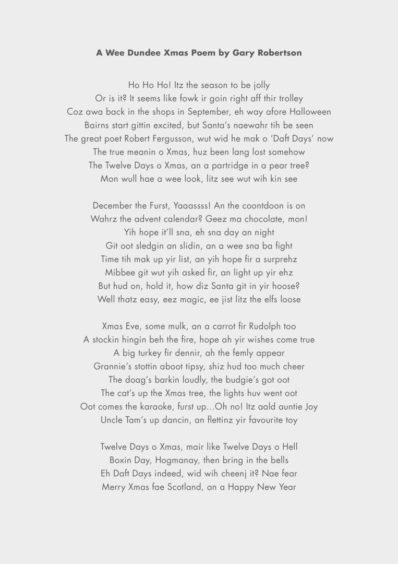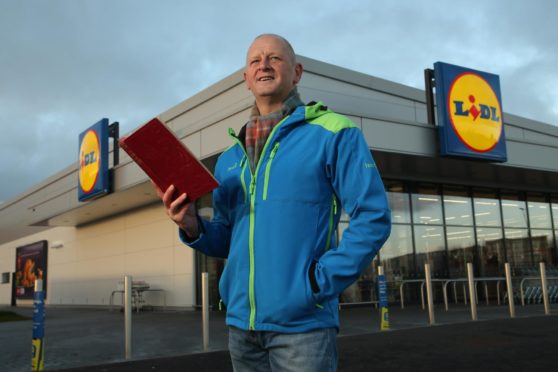Street poet Gary Robertson has penned a festive poem using a “forgotten” Scots phrase.
The Dundonian bard has used the saying “daft days” in his new piece, A Wee Dundee Christmas Poem.
The Scots saying was used to describe the festive feeling during the 12 days between Christmas and January 5.
It was most famously used by the 17th-century Scottish poet Robert Fergusson. The phrase has since fallen out of common use in Scotland.
Encouraged to bring back the saying, Gary writes in his poem: “Eh daft days indeed, wid wih cheenj it? Nae fear.”
 The award-winning poet made a name for himself using Dundee dialect in his verse.
The award-winning poet made a name for himself using Dundee dialect in his verse.
He said: “A Wee Dundee Xmas Poem is an ode to our city and the Dundonian way of celebrating the festive season. It’s rooted in family, friends and enjoying yourself.
“It’s been a great opportunity to reconnect with this potentially forgotten aspect of the Scots language while paying homage to Robert Fergusson — the ‘other Robert’ as he’s often referred to.”
The poem is not the first time Gary has got into the Christmas spirit. Last year, his band The Cundeez release a festive single, Christmas in the Schemes.
A video of Gary rattling through a list of local words went viral on social media last year.
Every Lidl helps
The poem was commission by budget supermarket Lidl as part of a partnership with the National Trust for Scotland.
Gary’s poem will be included in the Lidl Book of Big Adventures, which will available in all of the chain’s Scottish stores from December 10. It includes activities for children who want to use Scots to write their own poems.
Ross Millar, Lidl regional director for Scotland, said: “This project has certainly been an education for us all; uncovering the origins of ‘daft days’, the original Scottish 12 days of Christmas.
“Our aim is to celebrate all that makes Scotland unique, from food to culture.
“Daft days really is at the heart of Scotland’s festive season and we’re incredibly proud to celebrate this.”
Robert Fergusson
Scotland’s “other Robert” poet was born in 1750 in Edinburgh, just nine years before Robert Burns.
While his short career was overshadowed by that of Burns, Scotland’s national bard was said to have been inspired by Fergusson’s work.
A bronze statue of Fergusson sits outside the Canongate Kirk, Edinburgh, where he was buried after his death in 1774, aged just 24. He suffered head injuries after a fall.
Originally buried in an unmarked grave, Burns designed a memorial headstone to properly mark his friend. It was erected in 1787.










